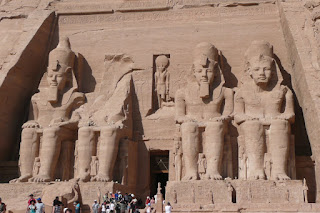
On Sunday, we left most of our luggage at the Indiana Hotel, and headed for Ramses Station and the 9 am train to Alexandria. We thought this was a two hour train, but it arrived in Alexandria at 12.
It was a short ride to our hotel, which is located across from the harbour. Our room has a wonderful view of the harbour. The hotel, called Le Metropole, was built in the grand style in 1902 and remains in beautiful condition. It is apparently one of the better hotels in town and is very much a step up in class from what we have experienced elsewhere on our trip.
There isn't that much to see in Alexandria. It gets numbers of tourists from cruise boats (most of whom are bused to Cairo to see the pyramids), as well as large numbers of Egyptians looking for a beach holiday in summer.
We walked around the harbour and had an excellent fresh fish meal at the Fish Market Restaurant.
We continued to wander for the afternoon. There are many old buildings which once must have been quite grand, but which are really in need of cleaning and restoration. Apparently, Alexandria was a thriving and even modern city from 1900 to about 1950, with impressive buildings and public features and parks, but it seems to have been in something of a decline since then. Some form of building renovation or restoration is happening for a few buildings (mainly bank buildings), there is a long way to go to make Alexandria an architectural jewel - the city suffers from the general uncleanliness, rubbish and decay that seems endemic in Egypt.
It isn't easy to find a restaurant that serves alcohol, but fortunately we did so for dinner and shared an expensive but welcome bottle of what passes for wine in Egypt - we are even getting close to appreciating it.
On Monday, we took the opportunity to sleep in - we felt that we had done our quota of early starts and we knew that we had to fly out at 4 am the next morning.
We then went for a stroll along the Corso, by the harbour, towards the new library (the Bibliotheca Alexandrina), which has a striking architecture and is airy and spacious internally.
We had a light lunch on the way back to our hotel and then headed for our 3 pm train back to Cairo. The train passes through densely farmed areas, watered by irrigation channels from the Nile or its delta. The fields are generally small, and mostly growing food crops. Tractors seem rare; the donkey is the universal aid. Egypt relies entirely on the Nile; if the Nile water isn't there to provide irrigation, the land is nothing but desert in all the areas were saw from Alexandria to Aswan and beyond.
We returned to the Indiana Hotel (using the Cairo Metro, which is surprising clean, efficient and cheap, even if not very extensive). We had a light meal and a short sleep, before rising at 12:30 am to taxi to Cairo Airport for our 4:15 am flight home, via Amsterdam and Kuala Lumpur.
It was a short ride to our hotel, which is located across from the harbour. Our room has a wonderful view of the harbour. The hotel, called Le Metropole, was built in the grand style in 1902 and remains in beautiful condition. It is apparently one of the better hotels in town and is very much a step up in class from what we have experienced elsewhere on our trip.
There isn't that much to see in Alexandria. It gets numbers of tourists from cruise boats (most of whom are bused to Cairo to see the pyramids), as well as large numbers of Egyptians looking for a beach holiday in summer.
We walked around the harbour and had an excellent fresh fish meal at the Fish Market Restaurant.
We continued to wander for the afternoon. There are many old buildings which once must have been quite grand, but which are really in need of cleaning and restoration. Apparently, Alexandria was a thriving and even modern city from 1900 to about 1950, with impressive buildings and public features and parks, but it seems to have been in something of a decline since then. Some form of building renovation or restoration is happening for a few buildings (mainly bank buildings), there is a long way to go to make Alexandria an architectural jewel - the city suffers from the general uncleanliness, rubbish and decay that seems endemic in Egypt.
It isn't easy to find a restaurant that serves alcohol, but fortunately we did so for dinner and shared an expensive but welcome bottle of what passes for wine in Egypt - we are even getting close to appreciating it.
On Monday, we took the opportunity to sleep in - we felt that we had done our quota of early starts and we knew that we had to fly out at 4 am the next morning.
We then went for a stroll along the Corso, by the harbour, towards the new library (the Bibliotheca Alexandrina), which has a striking architecture and is airy and spacious internally.
We had a light lunch on the way back to our hotel and then headed for our 3 pm train back to Cairo. The train passes through densely farmed areas, watered by irrigation channels from the Nile or its delta. The fields are generally small, and mostly growing food crops. Tractors seem rare; the donkey is the universal aid. Egypt relies entirely on the Nile; if the Nile water isn't there to provide irrigation, the land is nothing but desert in all the areas were saw from Alexandria to Aswan and beyond.
We returned to the Indiana Hotel (using the Cairo Metro, which is surprising clean, efficient and cheap, even if not very extensive). We had a light meal and a short sleep, before rising at 12:30 am to taxi to Cairo Airport for our 4:15 am flight home, via Amsterdam and Kuala Lumpur.






